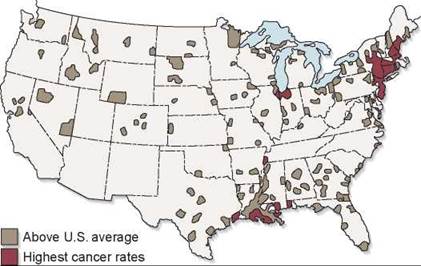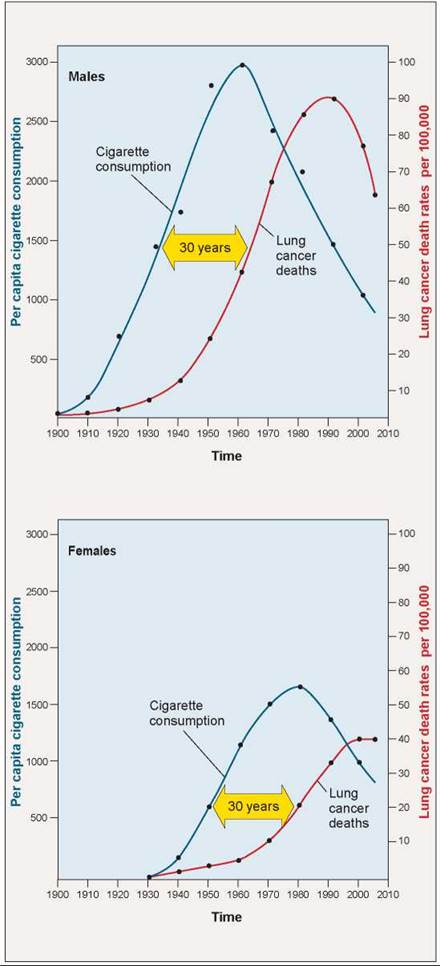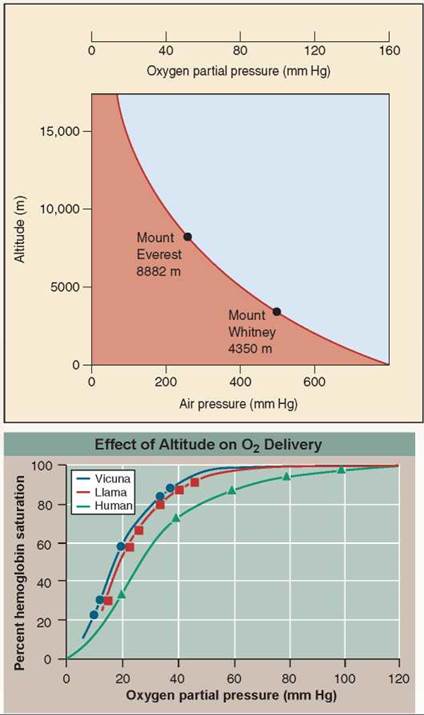THE LIVING WORLD
Unit Six. Animal Life
24.6. The Nature of Lung Cancer
Of all the diseases to which humans are susceptible, none is more feared than cancer (see chapter 8). Nearly one in every four deaths in the United States was caused by cancer in 2009. The American Cancer Society estimates that 562,340 people died of cancer in the United States in 2009. About 28% of these—157,910 people—died of lung cancer. About 140,000 cases of lung cancer were diagnosed each year in the 1980s, and 90% of these persons died within three years. Lung cancer is one of the leading causes of death among adults in the world today. What has caused lung cancer to become a major killer of Americans?
The search for a cause of cancers such as lung cancer has uncovered a host of environmental factors that appear to be associated with cancer. For example, the incidence of cancer per 1,000 people is not uniform throughout the United States. Rather, it is centered in cities, like the heavily populated Northeast indicated by the red areas in figure 24.7, and in the Mississippi Delta, indicated by the red and brown areas, suggesting that environmental factors such as pollution and pesticide runoff may contribute to cancer. When the many environmental factors associated with cancer are analyzed, a clear pattern emerges: Most cancer-causing agents, or carcinogens, share the property of being potent mutagens. Recall from chapter 11 that a mutagen is a chemical or radiation that damages DNA, destroying or changing genes (a change in a gene is called a mutation). The conclusion that cancer is caused by mutation is now supported by an overwhelming body of evidence.

Figure 24.7. Cancer in the United States.
The incidence of cancer per 1,000 people is not uniform throughout the United States. It is centered in cities where chemical manufacturing is common and in the Mississippi Delta.
What sort of genes are being mutated? In the last several years, researchers have found that mutation of only a few genes is all that is needed to transform normally dividing cells into cancerous ones. Identifying and isolating these cancer-causing genes, investigators have learned that all are involved with regulating cell proliferation (how fast cells grow and divide). A key element in this regulation are so-called tumor suppressors, genes that actively prevent tumors from forming. Two of the most important tumor-suppressor genes are called Rb and p53, and the proteins they produce are Rb and p53, respectively (recall from chapter 8 that genes are usually indicated in italics and proteins in regular type).
The Rb Protein
The Rb protein (named after retinoblastoma, the rare eye cancer in which it was first discovered) acts as a brake on cell division, attaching itself to the machinery the cell uses to replicate its DNA, and preventing it from doing so. When the cell wants to divide, a growth factor molecule ties up Rb so that it is not available to act as a brake on the division process. If the gene that produces Rb is disabled, there are no brakes to prevent the cell from replicating its DNA and dividing. The control switch is locked in the “ON” position.
The p53 Protein
The p53 protein, a tumor suppressor sometimes called the “guardian angel” of the cell, inspects the DNA to ensure it is ready to divide. When p53 detects damaged or foreign DNA, it stops cell division and activates the cell’s DNA repair systems. If the damage doesn’t get repaired in a reasonable time, p53 pulls the plug, triggering events that kill the cell. In this way, mutations such as those that cause cancer are either repaired or the cells containing them eliminated. If the gene that produces p53 is itself destroyed by mutation, future damage accumulates unrepaired. Among this damage are mutations that lead to cancer, mutations that would have been repaired by healthy p53. Fifty percent of all cancers have a disabled p53 gene.
Smoking Causes Lung Cancer
If cancer is caused by damage to growth-regulating genes, what then has led to the rapid increase in lung cancer in the United States? Two lines of evidence are particularly telling. The first consists of detailed information about cancer rates among smokers. The annual incidence of lung cancer among nonsmokers is about 17 per 100,000 but increases with the number of cigarettes smoked per day to a staggering 300 per 100,000 for those smoking 30 cigarettes a day.
A second line of evidence consists of changes in the incidence of lung cancer that mirror changes in smoking habits. Look carefully at the data presented in figure 24.8. The upper graph is compiled from data on men and shows the incidence of smoking (blue line) and of lung cancer (red line) in the United States since 1900. In 1920, lung cancer was still a rare disease. About 30 years after the incidence of smoking began to increase among men, lung cancer also started to become more common. Now look at the lower graph, which presents data on women. Because of social mores, a significant number of women in the United States did not smoke until after World War II (see blue line), when many social conventions changed. As late as 1963, only 6,588 women had died of lung cancer. But as women’s frequency of smoking has increased, so has their incidence of lung cancer (red line), again with a lag of about 30 years. Women today have achieved equality with men in the number of cigarettes they smoke, and their lung cancer death rates are now rapidly approaching those for men. In 2009, an estimated 70,000 American women died of lung cancer.

Figure 24.8. Incidence of lung cancer in men and women.
Lung cancer was a rare disease a century ago. As men in the United States increased smoking in the early 1900s, the incidence of lung cancer also increased. Women followed suit years later, and in 2008, more than 71,000 women died of lung cancer, a rate of 40 per 100,000. In that year, about 20% of women smoked and about 25% of men.
How does smoking cause cancer? Cigarette smoke contains many powerful mutagens, among them benzo[a]pyrene, and smoking introduces these mutagens to the lung tissues. Benzo[a]pyrene, for example, binds to three sites on the p53 gene and causes mutations at these sites that inactivate the gene. In 1997, scientists studying this tumor-suppressor gene demonstrated a direct link between cigarettes and lung cancer. They found that the p53 gene is inactivated in 70% of all lung cancers. When these inactivatedp53 genes are examined, they prove to have mutations at just the three sites where benzo[a] pyrene binds! Clearly, the chemical in cigarette smoke is responsible for the lung cancer.
In the face of these facts, why do so many people continue to smoke? Because the nicotine in cigarette smoke is an addictive drug. Researchers have identified the receptor on central nervous system neurons that it binds to, and they have demonstrated that smoking leads to a decrease in the brain’s population of these receptors, leading to a craving for more cigarettes. This mechanism of nicotine addiction is very similar to that of cocaine addiction; once a person becomes addicted, it is difficult to quit. About half of those who try eventually succeed. Because your life is at stake, it is well worth the effort.
Clearly, an effective way to avoid lung cancer is not to smoke. Life insurance companies have computed that, on a statistical basis, smoking a single cigarette lowers your life expectancy 10.7 minutes (more than the time it takes to smoke the cigarette!). Every pack of 20 cigarettes bears an unwritten label: The price of smoking this pack of cigarettes is 3 1/2 hours of your life. Smoking a cigarette is very much like going into a totally dark room with a person who has a gun and standing still. The person with the gun cannot see you, does not know where you are, and shoots once in a random direction. A hit is unlikely, and most shots miss. As the person keeps shooting, however, the chance of eventually scoring a hit becomes more likely. Every time an individual smokes a cigarette, mutagens are being shot at his or her genes. Nor do statistics protect any one individual: Nothing says the first shot will not hit. Older people are not the only ones who die of lung cancer.
Importantly, nonsmokers represented fully 15% of newly diagnosed lung cancers in 2007, and two-thirds of the nonsmoking lung cancer patients were women. In that year, lung cancer among nonsmoking women killed three times as many women as did cervical cancer. Very little research is being done to explore why nonsmoking lung cancer is so much more common among women than men. More studies should be conducted.
Key Learning Outcome 24.6. Cancer results from the mutation of genes that, when healthy, enable the cell to regulate cell division. Many of these mutations are caused by cigarette smoke.
Inquiry & Analysis
How Do Llamas Live So High Up?
Because of mixing, the air animals breathe is 21% oxygen everywhere, even way up into the sky 100 km above earth's surface. However, the amount of air (the number of molecules in a unit volume) decreases sharply with altitude, as shown in the upper graph. Air pressure at 5,000 meters is half that at sea level. This lack of air presents a serious problem to humans, as mountain climbers know. The amount of oxygen in the air (measured as oxygen partial pressure) is lower, so there is simply too little oxygen to fuel a climber's muscles. To combat this problem, high-altitude climbers typically spend months acclimating to high altitudes, a period in which their bodies greatly increase the amount of hemoglobin in their red blood cells and so increase the amount of oxygen the red blood cells can capture. Many mammals live their entire lives at high altitudes. The llama and the vicuna (pictured here) both live in the high Andes of South America, often above 5,000 meters. Do they stuff extra hemoglobin into their red blood cells too, or are they able to solve the problem of low oxygen in another way?

The graph on the lower right displays three "oxygen loading curves” that reveal the effectiveness with which hemoglobin binds oxygen. The more effective the binding, the less oxygen required before hemoglobin becomes fully loaded. In the graph, the percent hemoglobin saturation (that is, how much of the hemoglobin is bound to oxygen) is presented on the y axis, and the oxygen partial pressure (a measure of the amount of oxygen available to the hemoglobin molecules) is presented on the x axis. Oxygenloading curves are presented for three mammalian species: humans living at sea level, and llamas and vicunas, each living in the Andes above 5,000 meters.
1. Applying Concepts
a. Variable. In the graph on the lower right, what is the dependent variable(s)?
b. Comparing Curves. Extrapolating on the lower graph, which species possesses hemoglobin able to load oxygen well at sea level partial pressures (160 mm Hg)? Which of the three species possesses hemoglobin better able to load oxygen on Mount Everest (use data from upper graph)?
2. Interpreting Data
a. The partial pressure of oxygen in human muscle tissue at sea level is about 40 mm Hg. What is the percent hemoglobin bound to O2 for each of the three species at this partial pressure? What percent of the human hemoglobin has released its oxygen? Of the llama? Of the vicuna?
b. Are there any significant differences in the hemoglobin saturation values for the two high- altitude species?
3. Making Inferences. At an elevation of 5,000 meters, the partial pressure of oxygen is 80 mm Hg (half of what it is at sea level). At this elevation, how much of human hemoglobin has succeeded in binding oxygen? How much of llama hemoglobin? Of vicuna?
4. Drawing Conclusions. What is the effect of shifting the oxygen loading curve to the left? What general statement can be made regarding the affinity of hemoglobin for oxygen in the three species?
5. Further Analysis What saturation values would you expect in llamas raised from birth in the National Zoo at Washington, D.C.? Why would you expect this? How might you test your prediction?

1. In the gills of fish, countercurrent flow allows
a. the animal’s blood to be continually exposed to water of lower oxygen concentration.
b. the animal’s blood to be continually exposed to water of equal oxygen concentration.
c. the animal’s blood to be continually exposed to water of higher oxygen concentration.
d. for a larger surface area for gas exchange to occur.
2. The purpose of gill filaments and the lung alveoli is to
a. decrease the surface area available for gas exchange.
b. increase the surface area available for gas exchange.
c. decrease the volume available for gas exchange.
d. increase the volume available for gas exchange.
3. In general, the need for alveoli increases as the
a. energy need for different vertebrate classes increases.
b. energy need for different vertebrate classes decreases.
c. habitat for different vertebrate classes changes.
d. nutrition need for different vertebrate classes increases.
4. Which group of animals is the most efficient at extracting oxygen?
a. reptiles
b. birds
c. fish
d. mammals
5. Which of the following statements about the bird’s respiratory system is false?
a. Birds breathe using a crosscurrent flow of air and blood.
b. Birds have air sacs in addition to a lung.
c. It takes three cycles of breathing for air to pass through the bird’s respiratory system.
d. The bird’s respiratory system has two locations where air is held during inhalation.
6. When you take a deep breath, your chest moves out because
a. the incoming air expands the thoracic cavity.
b. contracting your abdominal muscles forces the chest cavity outward.
c. contracting the muscles around the thoracic cavity pulls your chest out.
d. positive pressure builds up in the lungs, expanding the chest cavity and forcing the chest out.
7. Oxygen is transported by
a. hemoglobin in red blood cells.
b. dissolving it in the blood plasma.
c. binding to proteins in the blood plasma.
d. platelets in the blood plasma.
8. Most of the carbon dioxide is transported
a. by hemoglobin in red blood cells.
b. as bicarbonate in the blood plasma.
c. by proteins in the blood plasma.
d. as carbonic acid in red blood cells.
9. Which of the following is not carried by hemoglobin?
a. bicarbonate
b. carbon dioxide
c. oxygen
d. super nitric oxide
10. Which of the following can lead to cancer?
a. smoking
b. pollution
c. mutations of Rb and p53
d. All of the above.